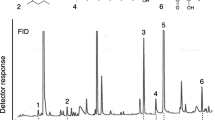Summary.
Trail-following behavior of Lasius japonicus was colony-specific in the field, while trail pheromone activity was not. We found that the footprint substance caused colony-specific trail-following behavior only when working in conjunction with the trail pheromone. The footprint substance alone did not lead the workers to follow trails. The substance consisted mainly of hydrocarbons with composition almost identical to that of cuticular hydrocarbons, except for the absence of n-alkanes. Nestmate workers shared footprint hydrocarbon profiles as well as cuticular hydrocarbons, but the profiles differed among colonies. We therefore consider that the footprint hydrocarbon profiles serve as the trail discrimination signal in L. japonicus.
Similar content being viewed by others
Author information
Authors and Affiliations
Corresponding author
Rights and permissions
About this article
Cite this article
Akino, T., Yamaoka, R. Trail discrimination signal of Lasius japonicus (Hymenoptera: Formicidae). Chemoecology 15, 21–30 (2005). https://doi.org/10.1007/s00049-005-0288-6
Received:
Accepted:
Issue Date:
DOI: https://doi.org/10.1007/s00049-005-0288-6




